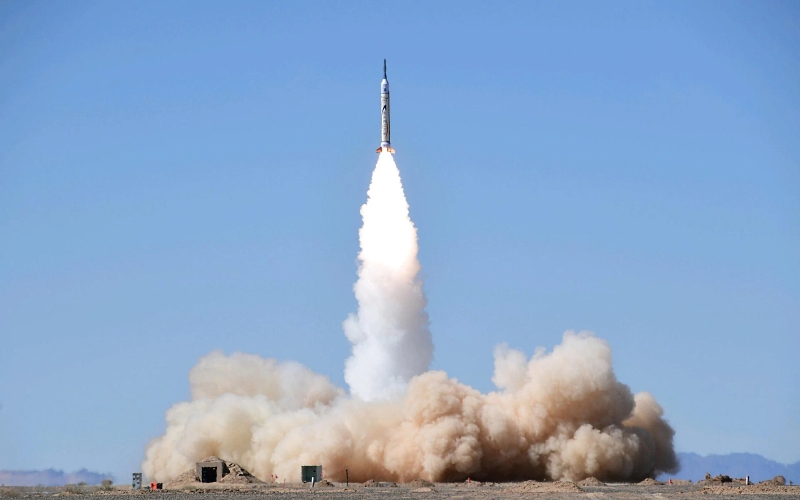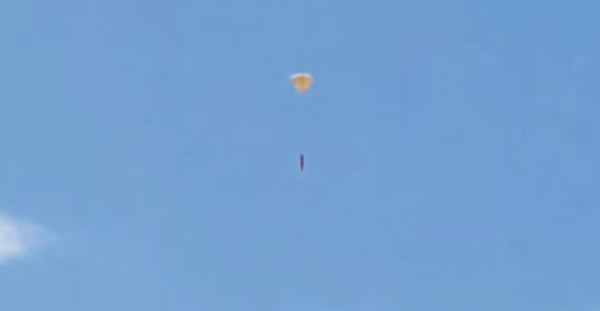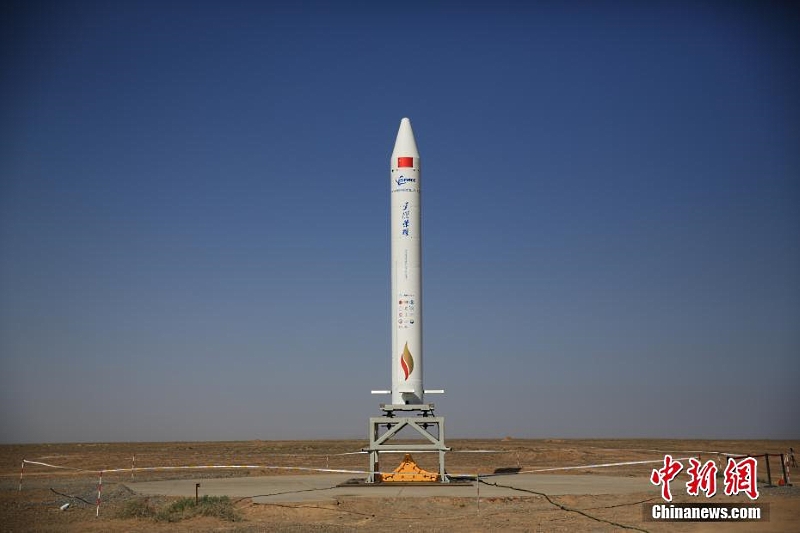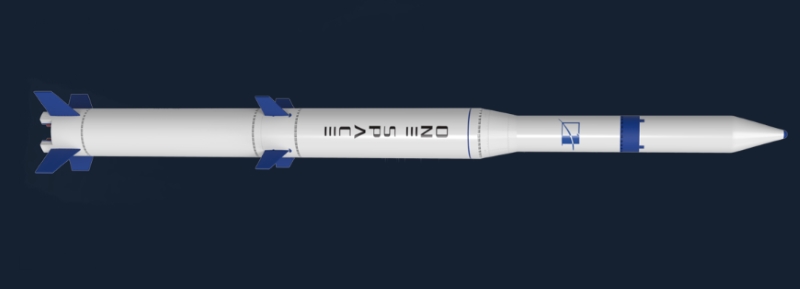Suborbital autumn
The end of summer and the beginning of autumn brought a bountiful harvest of suborbital launches of private companies - on August 25, the American SARGE (EXOS Airspace company) started for the first time; on September 5, the first commercial and second in order SQX-1Z launch, also Hyperbola-1S (i-Space) and on September 7, the first flight of OS-X1 (OneSpace). And for all three companies, this is just the beginning.

Start OS-X1, photo: Xinhua

SARGE start, shot from EXOS Airspace
The launch of the SARGE rocket forced the audience to clutch at the heart - in the first seconds of flight, leaving the starting ramp, the rocket noticeably tilted, but the control system was able to restore balance (launch at 20 minutes).
')
The flight was partially successful - the rocket climbed about 28 km from the planned 80. The GPS sensor led - the data temporarily disappeared, and the automation turned off the engine for 38 seconds instead of 62-65. But the rest of the equipment worked fine - the head part separated and made a soft landing with a parachute.

Frame from broadcast
It contained nine payloads — two experiments from Purdue University, children's and experimental devices, as well as investor badges and other memorabilia. The rocket opened the parachute-wing and made a controlled soft landing in the calculated area.

Next - fuel drain from tanks, shot from broadcast
When the rocket was found, it turned out that the intended consumable components had suffered only for this purpose, and the stage could make a repeated flight.
Structurally, SARGE is a single-stage geophysical rocket with a diameter of 51 cm and a height of 11 m, which is set in motion by an engine of 2.5 tons, operating on an ethyl alcohol-liquid oxygen fuel pair. The payload does not exceed 50 kg.

SARGE, Exos Airspace photo
The reason for the failure of the GPS sensor has not yet been found, especially since it transmitted correct data after the incident. But the cause of the roll at the start was established: the insufficiently fixed launch structure moved and transmitted torque to the rocket moving along it.
The success of SARGE opened the way to the next level for the company - a two-stage orbital Jaguar rocket has already been announced, which will have to launch up to 100 kilograms into an orbit 200-400 km high. Her first step will be made on the basis of increased SARGE and will also soft-fit and re-use. It is worth noting that for the EXOS Airspace employees it was a long and difficult road, many of them had previously worked in the frozen in 2013 Armadillo Aerospace, created by John Carmack.

On September 5, the Hyperbola-1Z rocket (SQX-1Z) launched and successfully climbed to a height of 108 km. She first flew in April 2018, and this time her first commercial launch took place. The payload was made in the cubsat form factor, so the news was written about the launch of satellites, but this is incorrect - the devices did not go into orbit. However, for several minutes they experienced zero gravity and worked in real space conditions. Of the three devices EREBUS-1, developed by Beijing ZeroG Technology Co. Ltd., made a soft landing with a parachute, and the fate of Tianfu Junrong-1 (TFJR-1) and Chengdu Gaoxin-1 (CDGX-1), created by Chengdu Guoxing Space Technology Co., Ltd., is not specified, but, obviously, they crashed when falling.
The SQX-1Z rocket consists of one solid-fuel stage, weighs 4.6 tons, has a diameter of 1 m and a height of 8.4 m. The i-Space company plans a four-stage Hyperbola-1 four-stage solid-fuel orbital launch vehicle with a loading capacity of 300 kg (launch is scheduled in the first half of 2019) and a two-stage rocket with the reusable Hyperbola-3 multi-stage first stage, capable of putting two tons into orbit (the first flight before the end of 2021).

Almost in parallel with i-Space, OneSpace is testing its rockets. OS-X0 climbed 40 km in May 2018, just a month behind SQX-1Z. And on September 7, just two days after the second launch of i-Space, OS-X1 went into flight. OS-X1 climbed only 35 km. It is alleged that the rocket is able to climb 500 km, but specifically in this case the wish of an unknown customer was fulfilled. But OneSpace had a great picture - the launch was filmed from the Chinese commercial satellite Jilin-1 (launched in January 2018, capable of shooting HD video from orbit).
OS-X is a single-stage solid-fuel rocket and, according to its characteristics, is close to the SQX-1Z - height 9 m, diameter 0.85 m. OneSpace plans an OS-M family of orbital launch vehicles with a carrying capacity of 200-500 kg.

OS-M in the lightest version without side accelerators, drawing from the official website
Suborbital launches are the first step for many companies in front of “real” space launches. They can already earn and receive valuable experience of this rocket business. Private space companies are actively developing in both the United States and China , so much more interesting news awaits us.

Start OS-X1, photo: Xinhua
The straightened sergeant

SARGE start, shot from EXOS Airspace
The launch of the SARGE rocket forced the audience to clutch at the heart - in the first seconds of flight, leaving the starting ramp, the rocket noticeably tilted, but the control system was able to restore balance (launch at 20 minutes).
')
The flight was partially successful - the rocket climbed about 28 km from the planned 80. The GPS sensor led - the data temporarily disappeared, and the automation turned off the engine for 38 seconds instead of 62-65. But the rest of the equipment worked fine - the head part separated and made a soft landing with a parachute.

Frame from broadcast
It contained nine payloads — two experiments from Purdue University, children's and experimental devices, as well as investor badges and other memorabilia. The rocket opened the parachute-wing and made a controlled soft landing in the calculated area.

Next - fuel drain from tanks, shot from broadcast
When the rocket was found, it turned out that the intended consumable components had suffered only for this purpose, and the stage could make a repeated flight.
Structurally, SARGE is a single-stage geophysical rocket with a diameter of 51 cm and a height of 11 m, which is set in motion by an engine of 2.5 tons, operating on an ethyl alcohol-liquid oxygen fuel pair. The payload does not exceed 50 kg.

SARGE, Exos Airspace photo
The reason for the failure of the GPS sensor has not yet been found, especially since it transmitted correct data after the incident. But the cause of the roll at the start was established: the insufficiently fixed launch structure moved and transmitted torque to the rocket moving along it.
The success of SARGE opened the way to the next level for the company - a two-stage orbital Jaguar rocket has already been announced, which will have to launch up to 100 kilograms into an orbit 200-400 km high. Her first step will be made on the basis of increased SARGE and will also soft-fit and re-use. It is worth noting that for the EXOS Airspace employees it was a long and difficult road, many of them had previously worked in the frozen in 2013 Armadillo Aerospace, created by John Carmack.
Direct hyperbole

On September 5, the Hyperbola-1Z rocket (SQX-1Z) launched and successfully climbed to a height of 108 km. She first flew in April 2018, and this time her first commercial launch took place. The payload was made in the cubsat form factor, so the news was written about the launch of satellites, but this is incorrect - the devices did not go into orbit. However, for several minutes they experienced zero gravity and worked in real space conditions. Of the three devices EREBUS-1, developed by Beijing ZeroG Technology Co. Ltd., made a soft landing with a parachute, and the fate of Tianfu Junrong-1 (TFJR-1) and Chengdu Gaoxin-1 (CDGX-1), created by Chengdu Guoxing Space Technology Co., Ltd., is not specified, but, obviously, they crashed when falling.
The SQX-1Z rocket consists of one solid-fuel stage, weighs 4.6 tons, has a diameter of 1 m and a height of 8.4 m. The i-Space company plans a four-stage Hyperbola-1 four-stage solid-fuel orbital launch vehicle with a loading capacity of 300 kg (launch is scheduled in the first half of 2019) and a two-stage rocket with the reusable Hyperbola-3 multi-stage first stage, capable of putting two tons into orbit (the first flight before the end of 2021).

Not makos
Almost in parallel with i-Space, OneSpace is testing its rockets. OS-X0 climbed 40 km in May 2018, just a month behind SQX-1Z. And on September 7, just two days after the second launch of i-Space, OS-X1 went into flight. OS-X1 climbed only 35 km. It is alleged that the rocket is able to climb 500 km, but specifically in this case the wish of an unknown customer was fulfilled. But OneSpace had a great picture - the launch was filmed from the Chinese commercial satellite Jilin-1 (launched in January 2018, capable of shooting HD video from orbit).
OS-X is a single-stage solid-fuel rocket and, according to its characteristics, is close to the SQX-1Z - height 9 m, diameter 0.85 m. OneSpace plans an OS-M family of orbital launch vehicles with a carrying capacity of 200-500 kg.

OS-M in the lightest version without side accelerators, drawing from the official website
Conclusion
Suborbital launches are the first step for many companies in front of “real” space launches. They can already earn and receive valuable experience of this rocket business. Private space companies are actively developing in both the United States and China , so much more interesting news awaits us.
Source: https://habr.com/ru/post/423461/
All Articles